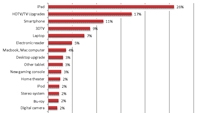HDTV, iPad top list of most desired consumer electronics

A new study on adoption of various pieces of consumer electronics indicates strong uptake of HDTVs in North America but comparatively low household penetration for Blu-ray players.
The study, conducted by customer intelligence firm Market Force Information, indicates that two-thirds of homes now have an HDTV, while only 15 percent own a Blu-ray player. Household ownership of those devices compares with 98 percent that own a computer, 97 percent that own a printer and 95 percent that own a camera. The level of Blu-ray player ownership matched gaming system ownership, even with significant price reductions over the past year, the research firm said.
Market Force, which surveyed more than 5600 consumers, found that despite the recession, 90 percent of consumers reported purchasing at least one electronic device either during the first half of 2010 (16 percent), in the last half of the year (62 percent) or immediately following the 2010 holidays (12 percent). Only 10 percent said they did not purchase any consumer electronics devices in 2010.
The survey also asked consumers which electronic devices they would buy if money were not a factor. The most frequently mentioned items were grouped into 16 major categories. The Apple iPad topped the list, followed closely by HDTV/TV upgrades; smart phones ranked third.
The Market Force study revealed that that 8 percent of consumers currently own a tablet, and penetration is trending to reach 25 percent in the next six months. The research firm reported three factors appear to be driving demand, including ease of mobility, frustration with small mobile phone screens and the availability of interesting applications.
The survey was conducted in December 2010 across the United States and Canada. The pool of respondents reflected a spectrum of income levels, with approximately 70 percent reporting household incomes of more than $50,000 a year. Respondents’ ages ranged from 19 to 70 years old. Approximately three-quarters of respondents were women, the primary household consumer purchasers, and an equal percentage work full or part time.
The professional video industry's #1 source for news, trends and product and tech information. Sign up below.
